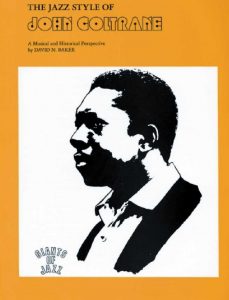Browse in the Library:
Or browse in the categories menus & download the Library Catalog PDF:
John Coltrane – “Giant Steps” Jazz Play Along

Coltrane Giant Steps
Giant Steps is a John Coltrane composition that quickly became famous among jazz musicians, but more as an obstacle course than jam session material. It was actually the same role that Cherokee had once played among the bebop musicians of the early 1940s, a piece that served to weed out musicians who weren’t up to the demands of modern jazz.
Writer and historian Ted Gioia summed this up perfectly by quoting that Gian Steps is a Cherokee on anabolics.
Please, subscribe to our Library.
If you are already a subscriber, please, check our NEW SCORES’ page every month for new sheet music. THANK YOU!
The song belongs to the album of the same name and Coltrane’s fifth studio album as leader, his first recording for Atlantic Records, recorded between May and December 1959, coinciding with the dates on which Coltrane participated in the classic Kind of Blue by Miles Davis. . This is how history is written, surprising, right?
During this recording, Coltrane breaks with the usual procedure of doing a maximum of two or three takes per song, needing between five and ten takes for the final result to be to his liking. In addition, Coltrane tried different rhythm sections for the recording, which gives us an idea of his obsession and perfectionism.
One way or another, Giant Steps is his album, the album for his loved ones. All the songs are his own compositions and show his gratitude towards his family and musician friends, with whom he was in absolute complicity. Mr PC is dedicated to double bass player Paul Chambers, and Naima, Cousin Mary or Syeeda’s Song Flute, to his wife and daughter.
Returning to the theme and looking at the harmonic progression, Coltrane used elements that other musicians had used previously, as an example the bridge of Have You Met Miss Jones, a classic theme composed by Richard Rodgers in 1937.
It seems that Tommy Flanagan, pianist on Coltrane’s first and only recording of the theme, was baffled by such a harmonic “ballot”. It’s understandable. Although it is also fair to say that during the 80s, Flanagan made several recordings of Gian Steps, showing that he had already had time to study the subject.
Coltrane put into practice here some improvisational patterns that he seemed to have devised beforehand. Various motifs and groups of four notes (permutations) that can be heard clearly and repeatedly in his solo.
There are those who maintain the thought that more than a song, Giant Steps is an exercise that Coltrane developed as part of the rigorous musical training that he imposed on himself, an exercise that once mastered he took off. Beyond this assessment, it is true that he rarely interpreted it again.
We cannot and should not forget this composition, since every self-respecting jazz musician should improvise on it, standing up to the harmonic flow plotted by Coltrane.
Best Sheet Music download from our Library.
In 2004, it was one of fifty recordings chosen that year by the Library of Congress to be added to the National Recording Registry. It attained gold record status in 2018, having sold 500,000 copies.
Two tracks, “Naima” and “Syeeda’s Song Flute”, are respectively named after Coltrane’s wife at the time and her daughter, whom he adopted. A third, “Mr. P.C.”, takes its name from the initials of bassist Paul Chambers, who played on the album. A fourth, “Cousin Mary”, is named in honor of Mary Lyerly, Coltrane’s younger cousin.
Personnel
Musicians
John Coltrane – tenor saxophone
Tommy Flanagan – piano
Wynton Kelly – piano on "Naima"
Paul Chambers – bass
Art Taylor – drums
Jimmy Cobb – drums on "Naima"
Cedar Walton – piano on "Giant Steps" and “Naima" alternate versions
Lex Humphries – drums on "Giant Steps" and “Naima" alternate versions